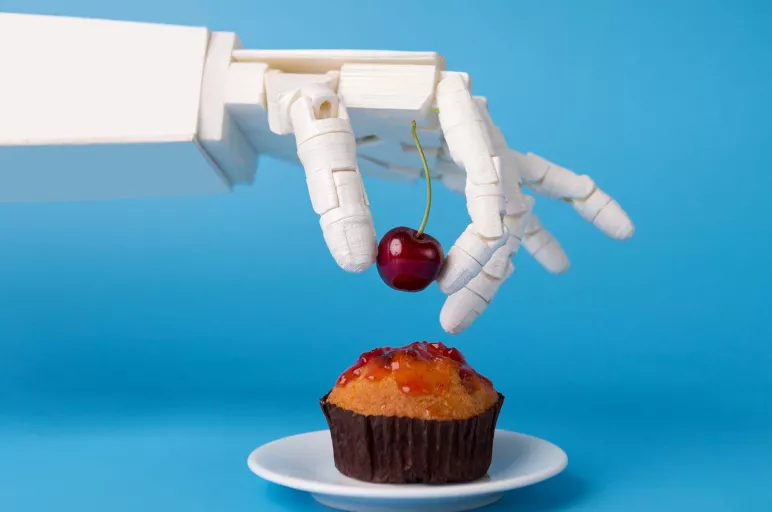
The Emerging Role of Robotics in the Food Processing Industry
- Automation and robots are playing a critical role in ingredient handling systems
- Robots are helping reduce production time, food waste and cost
- There are many challenges for the food industry to overcome, though
February 05, 2021 | Inventory Management
The global food processing industry represents a multi-billion market that experiences shifts in consumer preferences, which in turn impacts production and consumption trends, forcing manufacturers to consistently evolve their products.
Automation and robotics have penetrated an extremely wide spectrum of industries all over the world and the food industry is no exception. However, food processing has been one of the most difficult industries to automate owing to a variety of factors such as high volumes, variable size, shape and delicate nature of items. Moreover, production costs have risen due to the increased cost of ingredients and labor, and there are limited opportunities to raise product prices due to the competition in the retail and food service sectors.
Here, automation and robotics can play a crucial role in mass produced items to increase the production volumes in a limited time and reduce wastage.
The Evolution of Automation in Food Processing
Traditionally in the food processing sector, robotic applications are usually deployed in the latter stages of packaging such as in end-of-line product boxing and palletization. Therefore, there exists untapped potential in primary and secondary processing stages of food manufacturing, from operations on raw food such as cleaning, sorting, inspecting, measuring, preparing and transporting, to secondary processing including blending, cooking, chilling and assembling.
At present, food-handling lines are still heavily staffed by humans who can perform complex manipulation tasks. However, working conditions can be harsh; monotonous, dirty, and at times in cold rooms at freezing temperatures. It is estimated that manual handling and weighing ingredients can cost food manufacturers up to 5% of turnover every year. This is mainly attributed to manpower cost and material wastage. Moreover, employee turnover is often high in such applications, indicating the need for line operators to integrate more automation capabilities.
Obstacles for Automating the Food Processing Industry
There are numerous challenges faced by the food processing industry that limit the use of automation and robotics at various stages of the process of conversion.
Food manufacturers often deal with a variety of different raw materials. An important factor in primary food processing is the mixing of ingredients, which is traditionally by manually handling and weighing.
Another important factor is the intellectual property associated with a particular item and recipe secrets, that are known only to a few. Organizations are reluctant to share the same to a digital system which can be prone to malfunctions and data theft.
A crucial necessity for food-handling technology is washing. There are strict regulations that require the sanitization of any surface that comes into contact with food, often using caustic chemicals. Robots used in the food industry must be developed to meet these requirements, often at a high cost to the companies that develop them. Hence, capital as well as operating expenditure is high.
How Is Robotics Helping Overcome These Challenges?
Technologies such as high accuracy robots, machine learning and computer vision systems are increasingly emerging as innovative and flexible solutions to optimize ingredient handling operations.
For instance, an effective ingredient handling system has been developed by Olympus Automation, which consists of smart containers where individual ingredients are decanted and stored. The robot retrieves ingredients from the container and weighs them in a robotic blender as per the recipe programmed into the system. The system can store 500+ ingredients with a weighing accuracy of +/- 0.1 grams. These containers can handle multiple recipes and have an in-build cleaning mechanism. Moreover, the recipes can be programmed by the owner thus offering complete confidentiality and protection of intellectual property.
Conclusion
For a successful automated ingredient handling system, it is important to understand the specific ingredients being handled, safety and easy sanitization abilities. Careful evaluation of the cost benefits in implementing an ingredient handling system must be carried out before deciding to go with a particular system.
Sources and References
- https://www.robotics.org/blog-article.cfm/Robotics-in-Food-Manufacturing-and-Food-Processing/154
- https://www.newfoodmagazine.com/article/111886/food-manufacture-4-0-automation-and-robotics-at-the-service-of-food-manufacturing/
- https://www.roboticsbusinessreview.com/manufacturing/the_food_industrys_appetite_for_robotics/
Turn ideas into action. Talk to GEP.
GEP helps enterprise procurement and supply chain teams at hundreds of Fortune 500 and Global 2000 companies rapidly achieve more efficient, more effective operations, with greater reach, improved performance, and increased impact. To learn more about how we can help you, contact us today.

Paul Blake
Director, Product Marketing
Paul has spent over 30 years in diverse roles in the world of technology and was involved in the development of procurement software even before the advent of the internet.
Paul is GEP’s resident product evangelist who helps strategize and execute marketing plans for GEP’s full range of cutting-edge procurement and supply chain solutions.



